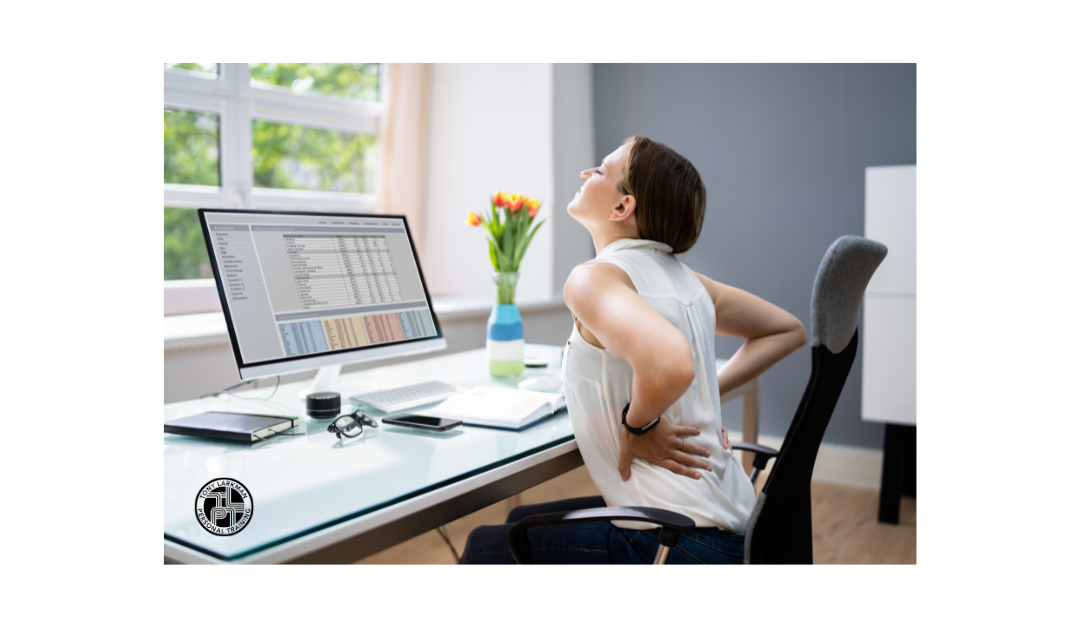Got a minute! With the words,“If you can fill the unforgiving minute with 60 seconds worth of distance run, yours is the Earth and everything that’s in it”, Rudyard Kipling reminds us to make the most of every second we have. It’s got me thinking about empty moments and how we can benefit physically if we fill them actively. Perhaps you’ve arrived at your PT session early, or you’re waiting for your running buddies to turn up, or even at home watching the kettle boil – how can you spend the time while you wait? Remember that ‘little and often’ of the right kind of moves can make all the difference and the benefits soon add up.
I’m inspired by Olympian Sally Gunnell who shares four exercises you can do in the morning while making coffee. She advocates 2-3 sets of: 10 squats, 10 press ups using the kitchen counter, floor or a chair, a wall sit for 30 seconds, split squats/10 on each leg – and then as she says, “You can enjoy your coffee.” A great example of time well spent! (1)
I also think this will be useful for those who work from home and are missing out on the physical challenge of a dash for the train each morning! For many, life has become more sedentary than before Covid struck and prolonged periods of sitting at a desk can have a negative impact on both mental and physical health. By incorporating bursts of movement during screen breaks and keeping up with exercise at either end of your working day, you have a chance to counteract the physical impact of WFH. This also applies to those who have made it to the office and find themselves desk-bound as well as muscle-bound.
Here are a few suggestions to fill those moments:
1. Dead hangs
This first one requires an overhead pull up bar and assumes you find yourself twiddling your thumbs in the gym or near outdoor gym equipment in your local park – beware hanging off a tree branch or anything unstable! Spending a minute doing a dead hang with your feet off the ground can stretch out the spine, which is particularly good if you’ve been sitting down for a long period.

The benefits:
– helps to decompress the spine
– relieves pressure in the lower back
– improves posture by mobilizing your upper body
– stretches the muscles and joints in the shoulders and upper back
– improves grip strength
The latter may not seem significant but research has shown that grip strength correlates with cardiovascular health and is thought to be a better indicator of longevity than blood pressure. The study was carried out by Queen Mary University, London, and found that better hand grip strength is linked to higher volumes of blood being pumped by the heart along with healthier heart structure and function, which lowers the risk of cardiovascular events like heart attacks and strokes. (2) (3) (4)
How to do a dead hang:
- Make sure of your grip on the bar before stepping off a bench onto it
- Avoid jumping up to the bar
- Arms should be shoulder width apart
- Use an overhead grip with palms facing away from you
- Keep arms straight and relax into the stretch with chin tucked down
- Squeeze your glutes and quads, while engaging your core
- Don’t let your lower back arch
- Step back down onto the bench slowly before releasing your arms
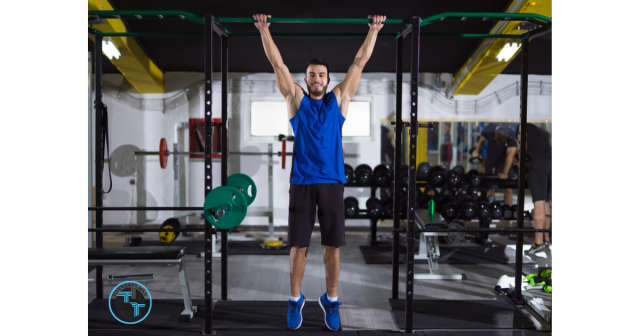
Anyone new to doing a dead hang should aim for around 10 seconds at first, eventually aiming for 30 seconds to 1 minute before or after your regular exercise and repeating up to 3 times.
Be wary of this exercise if you have any history of wrist, shoulder or elbow injury and avoid it if you are pregnant.
2. Sit on the floor
Yes, really! We aren’t naturally designed to sit in chairs for an extended period as they cause low back pain and tightened hip flexors, but sitting on the floor is hugely beneficial. I have to admit that more than a minute is needed here as around 15-20 minutes a day is optimal – perhaps take the opportunity while watching TV or playing with a toddler or pet. If you are WFH you could place your laptop on a low table in order to sit on the floor for a while. (5) (6) (7)
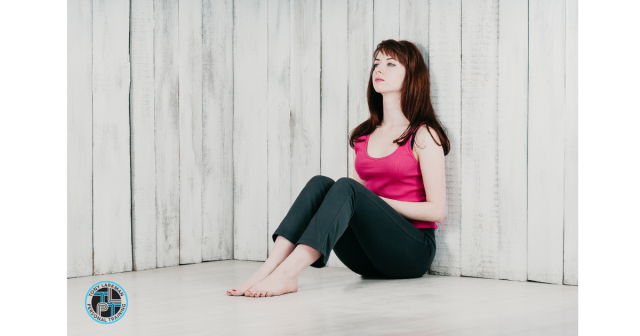
It’s recommended to sit on the floor with your back against a wall to ensure that you are not hunching over
The benefits:
- It is “active rest” and engages more muscle activity in the core and back to keep your body stable
- It will stretch your hip flexors and lower body muscles for increased flexibility
- It will actively stretch muscles and improve mobility
However, sitting on the floor incorrectly can cause problems such as, extra stress on your knees and ankles, reduced blood circulation, poor posture and exacerbating any existing joint problems! So, like anything, it’s important to do it properly!
How to sit
Cross-legged – You probably remember sitting comfortably like this in Assembly at primary school but, if it’s less comfortable now, think about shifting your weight to your hips and having your knees level with or below your hips. If it’s awkward to keep your back straight you can sit on the edge of a rolled blanket, bolster or yoga block and to decrease pressure on your hips you can place cushions beneath your knees. With practice it will become more attainable.
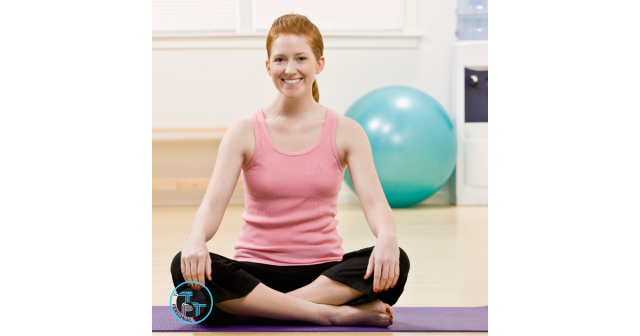
Sitting 90/90 – With one leg bent at a 90º angle in front of you and the other behind you also at a 90º angle your hips will rotate in two different ways and will effectively improve your hip mobility. Repeat on the other side.
Long sit – Keeping your back straight, extend your legs straight ahead and flex your toes. Sit on a rolled blanket if necessary to maintain the posture. This is very good for stretching your quad muscles.
Side sit – Lower both your knees to the right and onto the floor. Rest the bottom of your right foot against your left thigh while keeping both hips on the floor to keep your spine neutral. This will stretch your inner thighs. Repeat for the left side.
3. Standing on one leg
Now here’s something you can do wherever you are. When balancing on one leg, your brain integrates signals coming from the fluids in your inner ears, visual clues from your eyes and feedback from your joints and muscles. The signals from your eyes explains why this is so hard to do with your eyes closed and the ability to do this for a minute is something to build towards! As we age, the balance structure in our inner ear decreases, but you can actually overcome this by embracing the wobble. Remarkably, the brain will make new nerve connections and recalibrate, potentially continuing to improve our balance with every wobbling one leg stand. (8)

The benefits:
- It builds core strength and body alignment
- It improves neurological pathways
- It develops body awareness
In Yoga and Body Balance there are of course many one legged poses ranging from Tree and Eagle to Half Moon. For non-yogis, just standing on one leg is a simple exercise to fit into any part of your day, even when you are brushing your teeth!
4. Standing (lying) Pigeon Stretch
Those who practise yoga will know pigeon pose and here is an easier version that you could do in a few moments using your kitchen table or work desk during a screen break, remembering of course to switch off your camera! Place your right foot on the raised surface letting your knee drop to the side and your calf lie flat, perpendicular to your body. From here, fold forward slightly until you feel an outer hip and glute stretch, then walk your hands over to the right to add a twist and side stretch, walk hands back to the centre and then over to the left. Then switch to put your left foot up on the raised surface and repeat movements. (9)
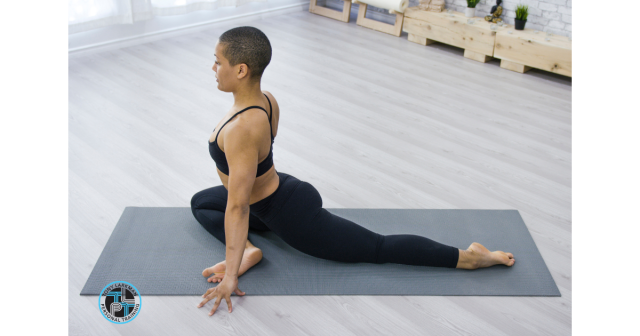
The pigeon stretch can be performed using a desk
The benefits:
- Promotes mobility in the hips
- Alleviates lower back tension
- Stretches thighs and glutes
5. Stand up
Like sitting on the floor, this seems an obvious one. But, if the majority of your working day requires you to sit at a desk, it is something that you need to make sure you do more often. Unfortunately, prolonged sitting is linked to heart disease, type 2 diabetes and cancer. There is even a campaign called Get Britain Standing, now in its 10th year, which promotes a dynamic workplace backed by NHS guidance advising us to get up and walk around for at least 5 minutes every hour. The campaign suggests adjustable sit-to-stand workstations so that you can alternate standing with seat-based work, interspersed with light walking around to alleviate any musculoskeletal fatigue. (10) (11)
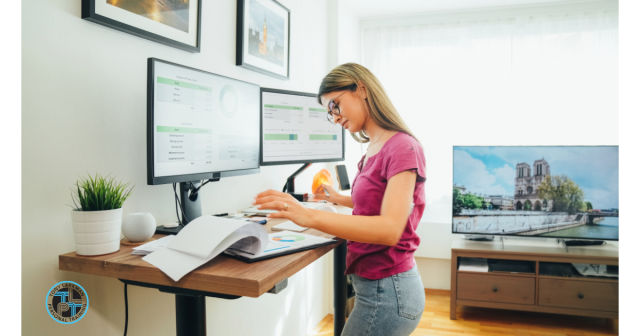
The benefits:
- Standing burns more calories than sitting, reducing the risk of obesity
- Reduces back pain by promoting better posture
- Improves blood flow, including to the brain, which triggers enhanced focus
If you feel you are in danger of being desk-bound during the day you might try the following:
- attend online (as well as in-person) meetings standing up
- take phone calls while walking
- have a walking meeting with a colleague
- schedule online meetings to be under an hour to allow time between to stand and stretch
Everyone has their own lifestyle and goals and I can only give general suggestions on how you might benefit physically from idle moments. Once you think about it I’m sure there are many, many other ways to keep yourself moving that will fit with what you do.
Perhaps …
- Bouncing – grab a skipping rope or rest your hands on the kitchen counter and bounce 50 times to raise your heart rate and improve your balance.
- Running up the stairs rather than walking – avoid the lift/escalator in an office
- Squeezing your glutes while waiting in a queue
- Or maybe, just maybe hiring a PT to turn up at your home/work and put you through your paces during lunchtime!
And so on …
How you fill Rudyard Kipling’s unforgiving minute is up to you …
Good luck and stay active!
- Sally Gunnell shares 3 exercises you can while waiting for the kettle to boil
- All you need to know about dead hangs
- Dead hang: A Simple Move with Big Benefits
- Weak handshake could be sign of a failing heart
- The 90/90 Stretch Can Improve Pain and Function in Your Hips and Back
- The Benefits and Precautions of Sitting on the Floor
- Sitting on the Floor May Help Improve Posture – Experts Recommend These 2 Positions
- Why you should stand on one leg
- 8 Yoga Poses You Can Do At Your Desk
- Sedentary working and how to combat the ‘sitting disease’
- Standing Desk Ergonomics: 7 Benefits of Standing at Work

